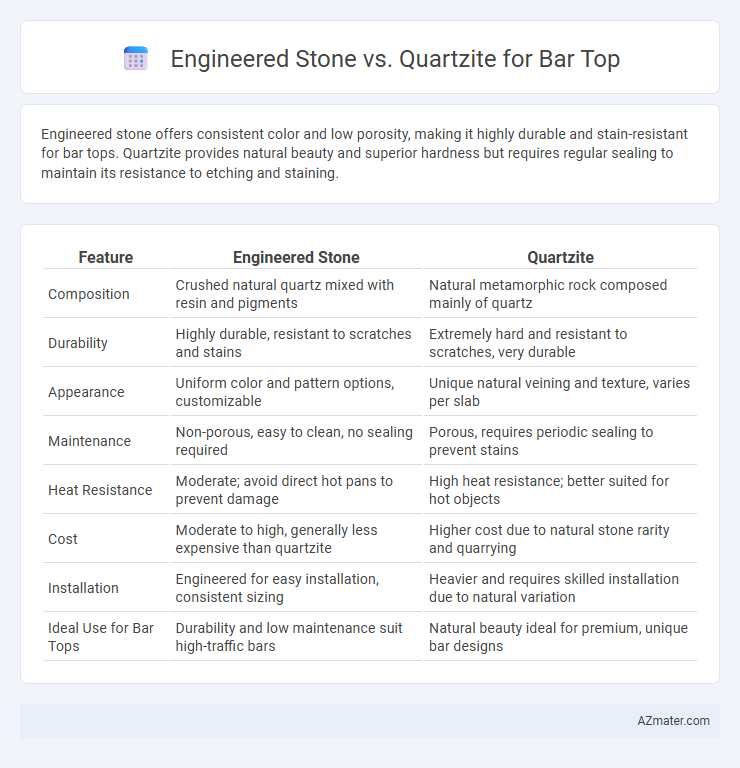Engineered stone offers consistent color and low porosity, making it highly durable and stain-resistant for bar tops. Quartzite provides natural beauty and superior hardness but requires regular sealing to maintain its resistance to etching and staining.
Table of Comparison
| Feature | Engineered Stone | Quartzite |
|---|---|---|
| Composition | Crushed natural quartz mixed with resin and pigments | Natural metamorphic rock composed mainly of quartz |
| Durability | Highly durable, resistant to scratches and stains | Extremely hard and resistant to scratches, very durable |
| Appearance | Uniform color and pattern options, customizable | Unique natural veining and texture, varies per slab |
| Maintenance | Non-porous, easy to clean, no sealing required | Porous, requires periodic sealing to prevent stains |
| Heat Resistance | Moderate; avoid direct hot pans to prevent damage | High heat resistance; better suited for hot objects |
| Cost | Moderate to high, generally less expensive than quartzite | Higher cost due to natural stone rarity and quarrying |
| Installation | Engineered for easy installation, consistent sizing | Heavier and requires skilled installation due to natural variation |
| Ideal Use for Bar Tops | Durability and low maintenance suit high-traffic bars | Natural beauty ideal for premium, unique bar designs |
Introduction: Engineered Stone vs Quartzite for Bar Tops
Engineered stone offers consistent patterns, durability, and stain resistance ideal for busy bar tops, while quartzite provides natural beauty with unique veining and exceptional hardness. Quartzite is more heat resistant but may require periodic sealing, whereas engineered stone typically needs less maintenance. Choosing between engineered stone and quartzite depends on balancing design preferences with functional requirements such as scratch resistance and upkeep.
Composition and Material Differences
Engineered stone is a blend of crushed natural quartz combined with resin binders and pigments, offering uniformity and enhanced durability, while quartzite is a naturally occurring metamorphic rock primarily composed of quartz grains fused under heat and pressure, resulting in a harder and more heat-resistant surface. Engineered stone's resin content provides stain resistance and flexibility in design colors, whereas quartzite's mineral composition offers natural veining and a unique, authentic appearance that can be more prone to etching and requires sealing. For bar tops, engineered stone delivers consistent performance and maintenance ease, while quartzite offers superior natural hardness and visual texture but demands more care to preserve its finish.
Appearance and Design Options
Engineered stone offers a consistent, customizable palette with a wide range of colors and patterns, often replicating natural stone aesthetics with enhanced durability. Quartzite showcases unique, natural veining and color variations, providing one-of-a-kind elegance and organic texture ideal for high-end bar tops. Both materials deliver a luxurious appearance, but engineered stone excels in design flexibility while quartzite emphasizes natural beauty and exclusivity.
Durability and Longevity Comparison
Engineered stone offers superior durability due to its non-porous composition, making it highly resistant to stains, scratches, and heat, which enhances its longevity for bar tops. Quartzite, a natural stone, provides excellent hardness and scratch resistance but requires periodic sealing to prevent moisture absorption and potential damage over time. Both materials are durable, but engineered stone generally offers longer-lasting performance with less maintenance in high-traffic bar top applications.
Stain and Scratch Resistance
Engineered stone offers superior stain resistance due to its non-porous surface, making it less likely to absorb spills compared to natural quartzite. Quartzite is harder and more scratch-resistant but requires sealing to protect against stains and maintain its appearance. For bar tops, engineered stone combines low maintenance with durable stain resistance, while quartzite demands regular care to preserve its natural beauty.
Maintenance Requirements
Engineered stone bar tops demand low maintenance due to their non-porous surface, resisting stains, scratches, and bacteria without needing sealing. Quartzite requires periodic sealing to protect against moisture and staining, making upkeep more intensive compared to engineered stone. Both materials benefit from routine cleaning with mild soap and water, but quartzite's natural composition necessitates cautious maintenance to preserve its durability and appearance.
Cost Comparison and Value
Engineered stone offers a more cost-effective option for bar tops, typically priced between $50 and $150 per square foot, compared to quartzite, which ranges from $70 to $200 per square foot due to its natural origin and hardness. Engineered stone provides consistent aesthetics and low maintenance, adding value through durability and stain resistance, while quartzite is valued for its unique, natural patterns and exceptional hardness, offering superior scratch and heat resistance. Choosing between the two depends on budget priorities and the desired balance between investment value and natural stone authenticity.
Installation Process and Considerations
Engineered stone offers a more consistent composition and easier installation due to its uniformity and pre-fabricated slabs, reducing the risk of cracking during cutting and fitting. Quartzite requires more skilled labor for installation because of its natural variability and hardness, which demands specialized tools and careful handling to avoid chipping. Considerations for engineered stone include ensuring proper support due to its weight and the need for professional adhesive application, while quartzite installations must account for sealing to maintain durability and stain resistance.
Environmental Impact and Sustainability
Engineered stone bar tops offer lower environmental impact due to their use of recycled materials and efficient manufacturing processes, reducing quarrying and waste compared to natural quartzite. Quartzite, as a natural stone, requires extensive quarrying and transportation, contributing to higher carbon emissions and habitat disruption. Choosing engineered stone enhances sustainability by minimizing resource depletion and promoting recyclability while maintaining aesthetic and durability standards.
Which is Better for Bar Tops? Final Verdict
Engineered stone offers superior consistency, stain resistance, and lower maintenance, making it ideal for high-traffic bar tops. Quartzite provides natural beauty and exceptional hardness but requires periodic sealing to prevent stains and etching. For durability, ease of care, and aesthetic versatility, engineered stone is the better choice for bar tops.

Infographic: Engineered stone vs Quartzite for Bar Top
 azmater.com
azmater.com